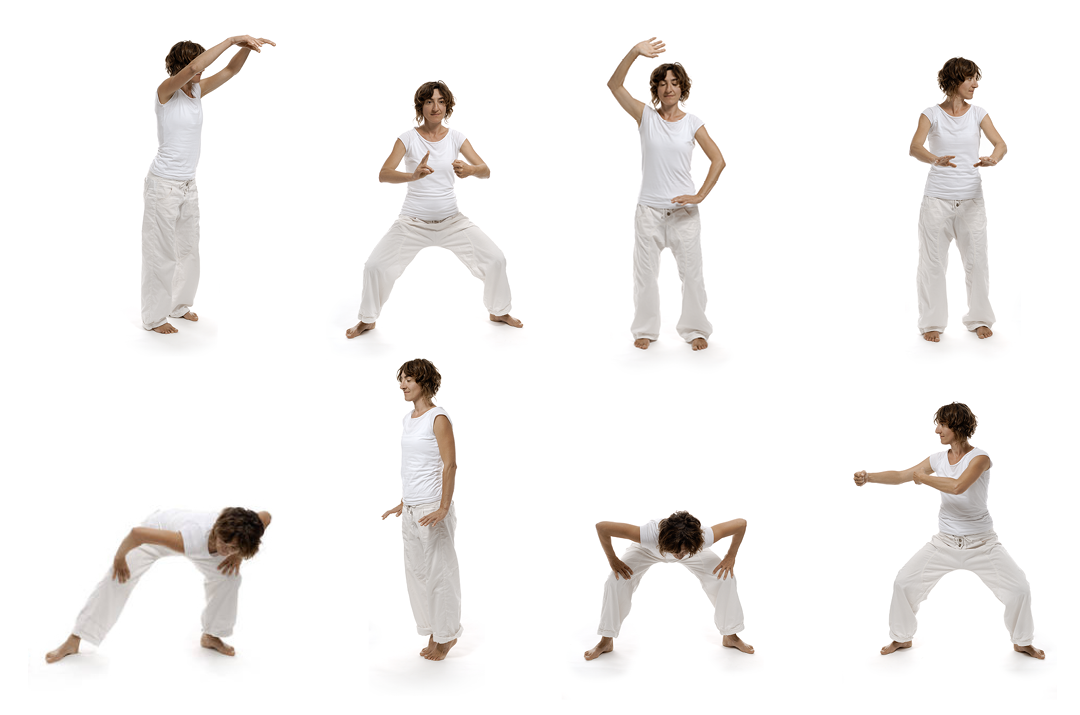Interprofessional collaboration between holistic and conventional doctors as well as professionals outside of the medical and helping profession is becoming the new normal for pain management. Yoga, Qi Gong, and other gentle movement exercises are entering this space, with the understanding of the mind-body connection to health and recovery.
We know that bodywork and prescriptions can temporarily ease pain, but they are often quick band-aids for the pain that has resulted from poor lifestyle habits including sedentary lifestyles from desk jobs and excessive smartphone and tablet use. While your practice can do wonders for their pain in the short term, a complementary exercise routine can give your patients the long-term results they are looking for.
As Mike Stella, Corrective Exercise Specialist and Performance Enhancement Specialist notes in Massage Magazine, “A multidisciplinary approach has been one of those medical pipe dreams that is slowly coming into the mainstream fold for one simple reason: Necessity.”
The modern lifestyle has wreaked havoc on the body from hunched bodies over their machines. But returning to exercise can partially remediate the damage your clients have done to their bodies.
No matter what kind of practitioner you are, you can add value to your clients’ or patients’ treatment by “prescribing” your clients movement exercises like Qi Gong for aftercare. This will help them loosen their joints and muscles and calm their mind to ease their painful symptoms.
Qigong’s Ability to Balance the Qi and Balance Body for Pain Management
Qi Gong takes the principles of Traditional Chinese Medicine TCM and puts it into action to balance the qi, the energy or life force that binds all things in the universe, including the human body’s internal organs and moving parts.
To TCM, when the qi stops flowing uninterrupted throughout the body or becomes imbalanced; mental, physical, and emotional issues can result.
Qi Gong is a practice of the mind, body, and spirit, which involves:
- Breathing
- Movement
- self-massage
- intention
- sound
The aim of Qi Gong is to open the meridians, or energy channels, that exist throughout the body so that the energy can move more freely. Qi Gong also helps to strengthen the mind-body connection, allowing for deeper understanding and communication with what is happening within one’s own body.
Physically, when integrating the moving postures associated with Qi Gong, circulation can improve, the muscles and tendons become warm and more flexible, and it helps to bring the organs and connective tissue into balance.
The concept of Yin and Yang play a major role in Qi Gong.
- Yin is more passive. It involves breathwork, gentle stretching, and guided meditation using imagery.
- Yang is more dynamic. It involves more dynamic movement. Yang Qi Gong is wonderful for helping support immune system function.
Baduanjin is a form of Qi Gong used to help those dealing with pain, be it acute or chronic. It is also known as the 8 Brocades, named after silken brocades. The movements are supposed to be smooth and silken as its name implies.
Created in the twelfth century, Marshal Yue Fei created Baduanjin with the aim of increasing the vitality of his soldiers. Now, Baduanjin is used to help alleviate and combat a great number of ailments, including addressing aches and pains with gentle movement, in both the East and the West.
To learn more about boosting your business with CBD Clinic™,
download your FREE E-Book
Getting Started With Qi Gong’s 8 Brochades
Jeff Chand, an acupuncturist and Qi Gong instructor, offers a wonderful video loaded with simple tricks your clients can do at home to heal any pain they might be feeling, especially in the low back. You can watch it here and be sure to share it with your clients.
We’ve also listed the 8 Qi Gong Brochades, their basic premise, and the techniques below.
1. Two Hands Hold Up the Heavens
 The first movement, two hands hold up the heavens, supports the “triple warmer” meridian. This meridian helps the practitioner manage his or her cortisol levels, epinephrine, and norepinephrine, the chemicals that influence our primal physical responses.
The first movement, two hands hold up the heavens, supports the “triple warmer” meridian. This meridian helps the practitioner manage his or her cortisol levels, epinephrine, and norepinephrine, the chemicals that influence our primal physical responses.
You can tell your clients, “try this exercise to control your flight, fight, or freeze responses to your stress so you can relax your body.”
To practice the movement:
Take a deep breath and exhale. Then start with your hands turned inwards at the waistline, legs shoulder-width apart with knees gently bent. Slowly straighten your legs and stretch your hands toward the sky. Remember to take long slow breaths in and out.
2. Drawing the Bow to Shoot the Hawk
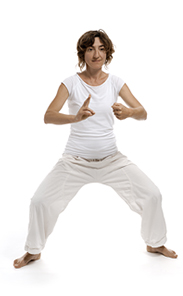 Drawing the bow to shoot the hawk is the second movement intended to strengthen to the lower extremities and waistline and balance to the kidney meridian.
Drawing the bow to shoot the hawk is the second movement intended to strengthen to the lower extremities and waistline and balance to the kidney meridian.
You can tell your clients, “try this exercise to strengthen your core and legs so you can stand strong. It’s like strengthening the trunk of a tree to hold up it straight and let its branches grow.”
To practice the movement:
Start with your legs shoulder-width apart with knees gently bent and remember to keep your back straight. Draw your hand the shape of a bow at the shoulder level. Pretend to pull the string hard like you are shooting a bow at a target. Then reverse the position. Remember to take long slow breaths in and out and keep your gaze forward towards the shooting hand.
3. Separating Heaven and Earth
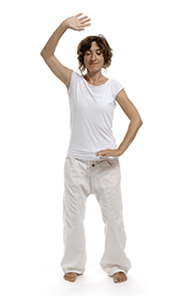 The third movement, separating heaven and earth, brings balance to the stomach and spleen meridian. It gently loosens stiff muscles in the front of the body as well by strengthening the tendons and muscles.
The third movement, separating heaven and earth, brings balance to the stomach and spleen meridian. It gently loosens stiff muscles in the front of the body as well by strengthening the tendons and muscles.
You can tell your clients, “this exercise can help relax your body and soothe your stiff joints and muscles.”
To practice the movement:
Start with your legs shoulder-width apart and remember to keep your back straight. Begin by making a fist, bend the elbows, and turn your fists inward until they touch. Pull the fist up with resistance like you are lifting a weight. Then separate the arms slowly as you draw one arm up to the sky and the other to the earth. Reverse the movement for balance.
4. The Wise Owl Gazes Backward
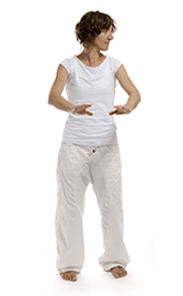 The wise owl gazes backward, the fourth movement, boosts energy and reduces stiff, sore muscles, especially those along the spine since this movement mimics a wringing out of a towel or rag.
The wise owl gazes backward, the fourth movement, boosts energy and reduces stiff, sore muscles, especially those along the spine since this movement mimics a wringing out of a towel or rag.
You can tell your patients, “try this exercise to reduce your muscle stiffness and soreness.”
To practice the movement:
Start with your legs shoulder-width apart and your hands loosely hung with your palms facing down. Make sure your hips and buttocks are tucked in. Open your arms slowly with your elbows to your hips and your palms facing forward. At the same time, twist your head slowly to one side. Reverse the movement for balance.
5. Punching With an Angry Gaze
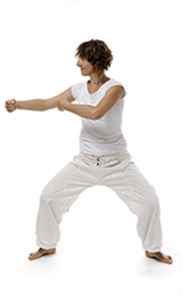 Punching with an angry gaze is the fifth movement in Banduanjin and beneficial to the liver meridian, which is associated with anger. It’s also an excellent exercise to practice with clients exhibiting stress that has surfaced as anger, which inevitably shows up in the body. This exercise promotes the flow of the qi for more balanced physical, mental, and emotional state. It is also an excellent exercise to loosen the hips, shoulder, and spine.
Punching with an angry gaze is the fifth movement in Banduanjin and beneficial to the liver meridian, which is associated with anger. It’s also an excellent exercise to practice with clients exhibiting stress that has surfaced as anger, which inevitably shows up in the body. This exercise promotes the flow of the qi for more balanced physical, mental, and emotional state. It is also an excellent exercise to loosen the hips, shoulder, and spine.
You can tell your clients, “practice punching the air slowly with an angry face to release tension emotionally and physically.”
To practice the movement:
Step with feet shoulder-width apart. Exhale and slowly bring your right closed fist forward with fingers toward the earth as you gently bend your knees. Inhale and bring your fist back, elbow bent, pushing slightly past your back. Then switch for balance. And remember to take long breaths in and out.
6. The Big Bear Turns Side to Side
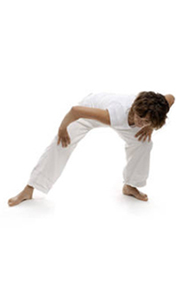 The sixth movement, the big bear turns side to side, helps optimize the flow of energy throughout the body. It is also an excellent exercise to loosen the hips. If you deepen the exercise with the whole body, it also loosens the upper spine.
The sixth movement, the big bear turns side to side, helps optimize the flow of energy throughout the body. It is also an excellent exercise to loosen the hips. If you deepen the exercise with the whole body, it also loosens the upper spine.
You can tell your clients, “try this exercise instead of a morning coffee and after a day of sitting to loosen your stiff sitting bones and joints.”
To practice this exercise:
Step with feet shoulder-width apart and hands on your hips. Take deep breaths in and out as your body side to side. Note, some people also deepen the exercise by rolling bending their head forward and rolling their body from the head the waist in a half-circle motion.
7. Touching Toes Then Bending Backward
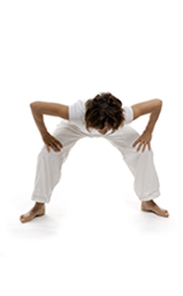 Touching toes then bending backward is good for stimulating the vital organs. It is also a great exercise for lengthening the hamstrings, hip muscles, upper back, and neck joints. It also gives a gentle massage to the spleen and liver. [Note: do not force yourself to stretch beyond discomfort or encourage your clients to do so].
Touching toes then bending backward is good for stimulating the vital organs. It is also a great exercise for lengthening the hamstrings, hip muscles, upper back, and neck joints. It also gives a gentle massage to the spleen and liver. [Note: do not force yourself to stretch beyond discomfort or encourage your clients to do so].
You can tell your clients, “Practice this exercise to stimulate the flow of energy in your body and to loosen the muscles and joints in the back of your legs, hips, rib cage area, upper back, and neck.”
To practice this exercise:
Stand with your feet at shoulder-width apart. Place your palms on your lower back and gently lean backward. Lift your chest upward. Exhale. Slide your hands slowly down the back of your legs and bring your hands forward to the front of your feet [or wherever you can reach comfortably]. Remember to tighten your abdomen slightly to protect your back during this practice.
8. Bouncing on the Toes
 Finally, bouncing on the toes is a great way to boost the immune system. It is also useful in increasing the energy flow in the body and strengthening your calf muscles.
Finally, bouncing on the toes is a great way to boost the immune system. It is also useful in increasing the energy flow in the body and strengthening your calf muscles.
You can tell your clients, “try this exercise to strengthen your calf muscles. Runners and gymnasts often do this type of exercise.”
To practice this exercise:
Stand with your feet shoulder-width apart. Inhale and slowly rise onto the balls of your feet until you are almost standing on the tip of your toes. Hold it a second. As you exhale, slowly drop your heels.
You can send your clients home with this infographic that reminds them of the exercises.

The Key Takeaway of Qi Gong for Aftercare
Integrating elements of Qi Gong would make a great addition to any massage, acupuncture, or other pain management practice. The exercises loosen and strengthen muscles and balance the qi in the body for optimal health. Remember, holistic care is a full-body experience that includes healthy lifestyle changes like adding gentle movement to the treatment plan.
It’s also a great way to work CBD CLINIC™ products into your treatment plan.
You can advise your clients to use a CBD CLINIC™ ointment right before or after practicing the Qi Gong exercise in order to help them temporarily relieve any minor pain they may be experiencing that limits their freedom of movement. This ointment harnesses the pain relieving active ingredients menthol and camphor.
Many of our clinicians have reported that their clients favor the Level 5 ointment as a partner to their exercise routine. The high levels of active ingredients, camphor and menthol, combined with the additional cooling essential oils and soothing emollients offer them temporary relief from their minor muscle and joint pains so they can move more freely.
The combination of your treatment, gentle exercise and CBD CLINIC™ minor pain relief products offers a well-rounded solution to treatment.
Disclaimer: This information is for educational purposes only. It has not been approved by the FDA to diagnose, treat, prevent, cure, or mitigate any diseases or conditions. We use CBD in our products for cosmetic purposes only.

